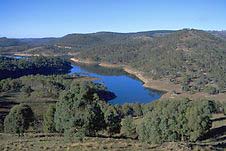
|
| Lake Lyell which provides
cooling water for Wallerawang Power Station
|
Wallerawang
Town connected to one of New South Wales' most important
power stations
Wallerawang is a town within the local government area of
Lithgow City which sprang up when the Wallerawang Power
Station opened in 1957. It is situated 156 km north-west of
Sydney and 900 m above sea-level on the western edge of the
Blue Mountains.
'Wallerawang' derives from the language of the Wiradjuri
Aborigines who occupied the area before white settlement. It
is said to mean 'place near wood and water' or 'plenty of
water'.
The first European in the immediate vicinity was James
Blackman who delineated the first road from Bathurst to the
present site of Wallerawang in 1820. The 'Wallerawong'
station was taken up by James Walker in 1824, although
Andrew Brown of 'Cooerwull' (see entry on
Lithgow) managed the property much of the time.
Wallerawang became a major stopover for those headed
between Sydney and the farming areas beyond Mudgee and for
those travelling between Sydney and Bathurst. One of the
latter was famous natural historian Charles Darwin who
stayed overnight at 'Wallerawang' farm in 1836 as a guest of
Mr Brown.
Two of Walker's convict servants took up land here in the
1850s (Maddox taking up Lidsdale). Walker's widow
established a small stone school in 1860 which is still
standing.
It was the arrival of the railway at Lithgow in 1869 (and
Wallerawang in 1870) which enabled the industrialisation and
hence the closer settlement of the valley. A town developed
adjacent Wallerawang station. Until the line to Bathurst was
completed in 1876 all passengers alighted at Wallerawang and
joined a Cobb & Co. coach for the journey west to Bathurst
or north to Mudgee.
St John's Church of England was erected in 1883 to a
design of Edmund Blacket, at the behest of James Walker's
daughter.
Oil-shale, coalmines and power generation have sustained
the town since that time. Around 1950 new town plans were
drawn up for Wallerawang, which was planned as a coal centre
for the railway line. However, when diesel power was
introduced those plans were abandoned. It is said the
Wallerawang power station was built as a compensation
measure.
The station has played an important part in the
development of the western coalfields of NSW as well as
furnishing power for the railways. However, since the
mid-1980s, automation, computerisation and rationalisation
have resulted in significant job losses from both the power
station and the local collieries.
Things to see:
![[Top of page]](smlArrow.gif)
Tourist Information
Tourist information is available from the Lithgow Visitors'
Centre, tel: (02) 6353 1859.
Lake Wallace
Lake Wallace is an artificial lake created to provide
cooling water for the Wallerawang Power Station. It also
offers recreational opportunities for local employees and
visitors. Fishing, sailing, trout fishing and canoeing.can
all be pursued (no power boats are allowed) and there are
picnic, barbecue and childrens' play facilities. Birdlife is
abundant, in particular the black swans and white-faced
herons.
Wallerawang Power Station
Tours of Wallerawang Power Station can be organised by prior
arrangement: ring Delta Electricity on (02) 6352 8611.
The power station has played an important part in the
development of the western coalfields of NSW as well as
furnishing power for the railways. It has a total capacity
of 1000 megawatts, producing electricity by means of
coal-fired boilers and steam-driven turbo-generators.
Lacking the salt water available for cooling at coastal
power stations, Wallerawang uses a system of cooling towers
with water supplied from Lakes Wallace and Lyell.
Over 75 per cent of the power station's coal is provided
by the nearby Angus Place colliery with the remainder
supplied by local privately owned mines. The coal is then
taken by conveyor to the power station's pulverising mills,
where it is crushed to a fine powder before being burnt in
the furnace. Up to 2.2 million tonnes of coal are consumed
each year.
St John's Church of England
St John's Church of England in Main St is a stone building
designed by Edmund Blacket and built in 1883 at the behest
of Georgina Lyons Barton, the daughter of James Walker. The
Barton family owned the old Wallerawang estate which was
then known as Barton Park.
Jannei Goat Dairy
Jannei Goat Dairy is located at 8 View St, Lidsdale. It is a
working dairy making fresh cheeses, waxed cheeses, yoghurt
and unpasteurised goats' milk. It is open from Monday to
Wednesday from 9.00 a.m. to 4.00 p.m. and on Friday and
Saturday from 10.00 a.m. to 5.00 p.m., tel: (02) 6355 1107.
If you are visiting the farm for the first time, knock at
the dairy and if there is no response sound your horn a few
times. Someone will be with you in a few minutes.

Broadwalk
Business Brokers
Broadwalk Business
Brokers specialise in General Businesses for Sale, Caravan Parks for
Sale, Motels for Sale, Management Rights & Resorts for Sale, Farms for
Sale, Hotels for sale,Commercial & Industrial Properties for Sale.
Phone:
1300 136 559
Email:
enquiries@broadwalkbusinessbrokers.com.au
AUSTRALIAN BUSINESSES FOR SALE
COFFS HARBOUR BUSINESS BROKERS
BROADWALK BUSINESS BROKERS
GOLD COAST BUSINESSES FOR SALE
BRISBANE BUSINESSES FOR SALE
SYDNEY BUSINESSES FOR SALE
CARAVAN PARKS FOR SALE
BUSINESSES FOR SALE
MOTELS
FOR SALE
HOTELS
FOR SALE
Disclaimer
We advise prospective purchasers that we take no
responsibility for the accuracy of any information in the business
provided by vendors or their professional advisers and that they should
make their own enquiries as to the accuracy of this information,
including obtaining independent legal and/or accounting advice
Wallerawang